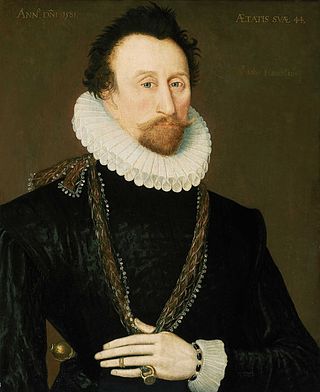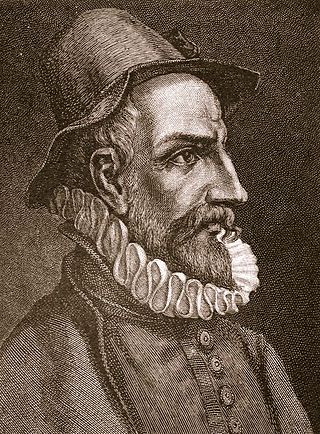
Sir Ferdinando Gorges was a naval and military commander and governor of the important port of Plymouth in England. He was involved in Essex's Rebellion against the Queen, but escaped punishment by testifying against the main conspirators. His early involvement in English trade with and settlement of North America as well as his efforts in founding the Province of Maine in 1622 earned him the title of the "Father of English Colonization in North America," even though Gorges himself never set foot in the New World.

Admiral Sir John Hawkins was an English naval commander, naval administrator, privateer and slave trader.

HMS Fury was a Hecla-class bomb vessel of the British Royal Navy.

Johann Baptist Fischart was a German satirist and publicist.

Leiston Abbey outside the town of Leiston, Suffolk, England, was a religious house of Canons Regular following the Premonstratensian rule, dedicated to St Mary. Founded in c. 1183 by Ranulf de Glanville, Chief Justiciar to King Henry II (1180-1189), it was originally built on a marshland isle near the sea, and was called "St Mary de Insula". Around 1363 the abbey suffered so much from flooding that a new site was chosen and it was rebuilt further inland for its patron, Robert de Ufford, 1st Earl of Suffolk (1298-1369). However, there was a great fire in c. 1379 and further rebuilding was necessary.
John Dickenson was an English author, known as a romance-writer. He was a follower in the school of John Lyly and Robert Greene. He worked for a time in the Low Countries, and Germany. Employed by George Gilpin and Ralph Winwood, he may have been a spy, and certainly was an agent of the government on the ground at the time of the War of the Jülich succession of 1610. He was employed on further missions, in Poland and Scandinavia.

Sir Thomas Shirley, of Wiston in Sussex, was an English Member of Parliament, government official and courtier who is said to have suggested the creation of the title of baronet.
This is a list of Sheriffs and High Sheriffs of Suffolk.
Sir John Spring, of Lavenham, Buxhall, Hitcham, and Cockfield, Suffolk, was an English merchant and politician.
Timothie Bright, M.D. (1551?–1615) was an English physician and clergyman, the inventor of modern shorthand.
Thomas Herbert was a Welsh seaman and author.
Batholomew Young or Yong was the translator of Montemayor's Spanish pastoral romance Diana into English.
Admiral Luke Warde, was an English naval officer who served during the Tudor period.
James Wadsworth (1604–1656?), was an English man who on a sea voyage to Spain in 1622 was captured by Moorish pirates and sold into slavery. A year later his freedom was purchased and he joined his parents in Madrid. After spending a number of years on the European continent, he returned to England, where he and a group of fellow pursuivants found and delivered suspected Roman Catholics to the authorities for trial and punishment.

Edward Vernon Utterson was a British lawyer, literary antiquary, collector and editor. He was a fellow of the Society of Antiquaries, one of the original members of the Roxburghe Club, a member of the Athenaeum Club, Camden Society and Royal Society of Arts, Recorder of Chichester and a Trustee of the Royal Victoria Yacht Club. He went on to become one of the Six Clerks in Chancery, a position which he kept until his retirement on the abolition of the post in 1842, and also founded the Beldornie Press.
John Mitford (1781–1859) was an English clergyman and man of letters.
Henry Roberts was an English writer and poet. His works are all of extreme rarity, may be identical with the "Henrie Roberts, one of the sworne esquires" of Queen Elizabeth and envoy from her highness to "Mully Hamet, emperour of Marocco and king of Fes", in 1585, whose embassy is recounted in Richard Hakluyt's Voyages. He was subsequently attached to the court of James I, and was present at the festivities upon the occasion of the visit of Christian IV of Denmark to England in 1606.
Sir John Burgh was an English military and naval commander and privateer. He took troops from Lincolnshire to serve in the Netherlands in 1585; was subsequently knighted; made governor of Doesburg; and governor of the Briel in early 1588; commanded one of the English regiments which helped Henry IV of France in 1589–90, and was knighted on the field at Ivry in 1590; finally commanded the squadron which captured the great Spanish treasure-ship off the Azores in 1592, and was killed in a duel respecting the plunder.
James Ralfe was a British writer on naval history.
Edward Scarisbrick, also known as Edward Neville, was an English Jesuit.








